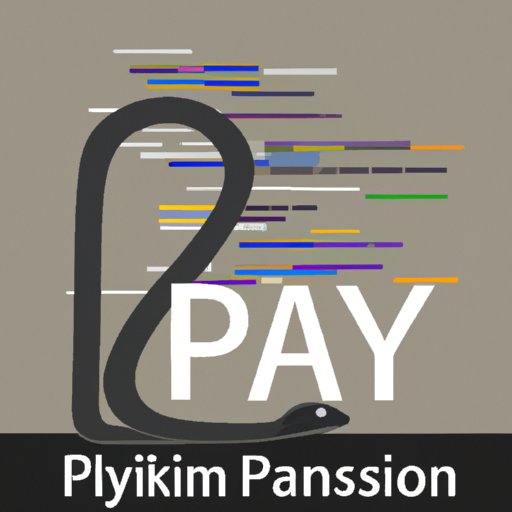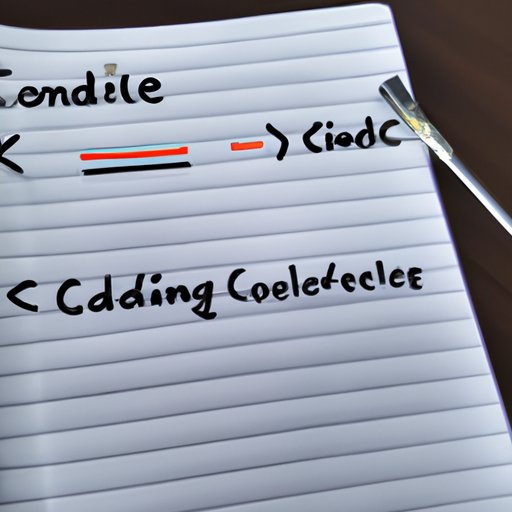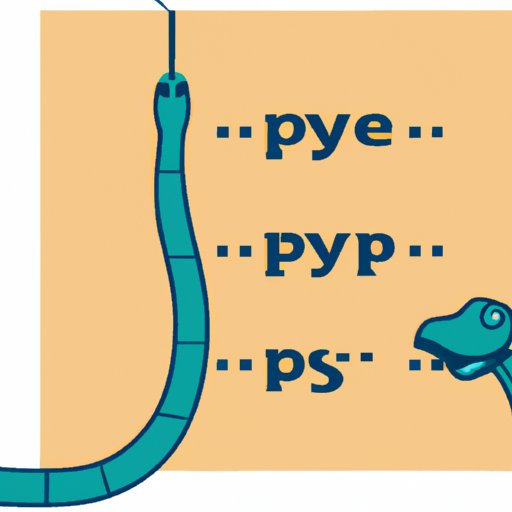Introduction
Python is a popular, high-level programming language used by many software developers, data scientists, and web developers. It is easy to learn and can be used to create powerful applications. Learning how to write code in Python will open up new possibilities for your career and projects. This article will provide an overview of the basics of Python programming and then provide a step-by-step guide on how to start writing code in Python.

Research the Basics of Python Programming
Before you start writing code in Python, it’s important to have a good understanding of the language itself. You should familiarize yourself with the basic concepts and syntax of the language, as well as the most commonly used libraries and frameworks. Here are some key areas to research:
What is Python?
Python is an interpreted, high-level programming language. It was designed to be readable, concise, and efficient. It is widely used in web development, data science, artificial intelligence, and game development. Python is also platform-independent, meaning it can be used on any operating system.
Key Aspects of Python Programming
It is important to understand the basic concepts of Python programming. These include variables, functions, classes, and modules. Understanding these aspects will help you write better code and develop more complex programs. Additionally, you should familiarize yourself with the syntax of the language and how it is used to create programs.
Common Libraries and Frameworks
When writing code in Python, you will often use libraries and frameworks. These are collections of pre-written code that make it easier to create programs. Some of the most popular libraries and frameworks for Python include NumPy, SciPy, Pandas, Django, Flask, and TensorFlow. Researching these tools will help you understand how to use them to create powerful applications.

Utilize Online Tutorials and Resources
Once you have a basic understanding of the language, you can start to learn how to write code in Python. There are many online tutorials and resources available to help you get started. Here are some tips for finding quality tutorials and resources:
Finding Quality Tutorials
Look for tutorials written by experienced developers or instructors. Check reviews and ratings to make sure the tutorial is of high quality. Additionally, look for tutorials that teach the fundamentals of Python programming, such as variables, functions, classes, and modules. Finally, make sure the tutorial is up to date and uses the latest version of Python.
Working Through Examples
One of the best ways to learn how to write code in Python is to work through examples. Many tutorials include sample code that you can download and run. Working through the examples will help you understand the syntax and structure of Python programs. Additionally, you can modify the example code and experiment with different features of the language.
Set Up a Development Environment
After you have a basic understanding of the language and have worked through some examples, it’s time to set up a development environment. This is where you will write and execute your Python programs. Here are some tips for setting up a development environment:
Choosing an Integrated Development Environment (IDE)
An IDE is a program that provides a complete environment for writing and executing code. Popular IDEs for Python include PyCharm, Visual Studio Code, and Spyder. Each has its own unique features and advantages, so it’s important to research them and decide which one is best for your needs.
Installing the IDE
Once you have chosen an IDE, you need to install it. Most IDEs are available for free and can be downloaded from their official websites. The installation process is usually straightforward and can be completed in just a few minutes.
Configuring the IDE
Once the IDE is installed, you need to configure it. This includes setting up your project structure, adding libraries and frameworks, and configuring the editor. Many IDEs come with built-in tutorials that will walk you through the configuration process.
Write Your First Program
Now that you have a development environment set up, you can start writing your first program. Here are some tips for writing and executing your first program:
Creating the Program
Start by creating a new file in the IDE. This is where you will write your code. Make sure to save the file with the .py extension. Next, write the code for your program. Keep it simple at first and focus on learning the basics of the language. Once you have finished writing the code, save the file.
Executing the Program
Once you have saved your program, you can execute it. This means running the code to see if it works. Most IDEs have a “Run” button that will execute the code. Alternatively, you can use the command line to execute the code. Either way, you should see the results of your program once it has been executed.
Debugging the Program
If your program doesn’t work, you may need to debug it. This means finding and fixing errors in the code. Most IDEs have debugging tools that can help you find and fix errors. Additionally, some IDEs offer features such as code completion and syntax highlighting that can help you write better code.

Experiment and Practice Writing Code
Once you have written your first program, it’s time to start experimenting and practicing. This will help you become more familiar with the language and gain a deeper understanding of how to write code in Python. Here are some tips for experimenting and practicing:
Exploring Different Syntaxes
Python has many different syntaxes that you can use to write code. Experiment with different syntaxes to see which one works best for your program. Additionally, practice using the syntax to build more complex programs.
Learning New Libraries and Frameworks
As you become more familiar with the language, start exploring different libraries and frameworks. Research how to use them and practice writing programs that utilize them. This will help you become more proficient in the language and create more powerful applications.
Participating in Coding Challenges
Many websites offer coding challenges that will test your skills and help you learn how to write code in Python. Participating in these challenges can be a fun and rewarding way to learn the language and sharpen your skills.
Conclusion
Learning how to write code in Python is a great way to open up new opportunities for your career and projects. This article has provided an overview of the basics of Python programming and a step-by-step guide on how to start writing code in Python. The steps include researching the language, utilizing online tutorials and resources, setting up a development environment, writing your first program, and experimenting and practicing with the language. With the right resources and dedication, you can quickly become proficient in Python programming.
(Note: Is this article not meeting your expectations? Do you have knowledge or insights to share? Unlock new opportunities and expand your reach by joining our authors team. Click Registration to join us and share your expertise with our readers.)
